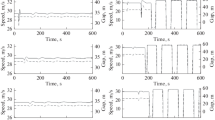Abstract
In this paper, a new car-following model of traffic flow is proposed by considering the driver’s individual anticipation behavior (forecast behavior and response delay behavior). The effect of anticipation parameters corresponding to the individual differences upon the stability of traffic flow is examined through linear stability analysis. The simulation results are in good agreement with the theoretical analysis and confirm that traffic flow can be stabilized efficiently by drivers’ forecast effect (positive anticipation parameter) and, nevertheless, be destabilized by drivers’ physical delay effect (negative anticipation parameter). Thus, the two aspects of drivers’ individual anticipation behavior play an important role in stabilizing or destabilizing the traffic system, respectively.










Similar content being viewed by others
References
Bando, M., Hasebe, K., Shibata, A., Sugiyama, Y.: Dynamical model of traffic congestion and numerical simulation. Phys. Rev. E 51, 1035–1042 (1995)
Ge, H.X., Dai, S.Q., Xue, Y., Dong, L.Y.: Stabilization analysis and modified Korteweg–de Vries equation in a cooperative driving system. Phys. Rev. E 71, 066119 (2005)
Ge, H.X., Zhu, H.B., Dai, S.Q.: Effect of looking backward on traffic flow in a cooperative driving car following model. European Physics Journal B. 54, 503–507 (2006)
Hasebe, K., Nakayama, A., Sugiyama, Y.: Dynamical model of a cooperative driving system for freeway traffic. Phys. Rev. E 68, 026102 (2003)
Li, Z.P., Liu, Y.C.: Analysis of stability and density waves of traffic flow model in an ITS environment. Eur. Phy. J. B 53, 367–374 (2006)
Wang, T., Gao, Z.Y., Zhao, X.M.: Multiple velocity difference model and its stability analysis. Acta Phys. Sin. 55, 634–640 (2006)
Ge, H.X., Cheng, R.J., Li, Z.P.: Two velocity difference model for a car following theory. Phys. A. 387, 5239–5245 (2008)
Jin, S., Wang, D.H., Tao, P.F., Li, P.F.: Non-lane-based full velocity difference car following model. Phys. A 389, 4654–4662 (2010)
Yu, L., Shi, Z.K., Zhou, B.C.: Kink–antikink density wave of an extended car-following model in a cooperative driving system. Commun. Nonlinear Sci. Numer. Simul. 13, 2167–2176 (2008)
Peng, G.H., Sun, D.H.: A dynamical model of car-following with the consideration of the multiple information of preceding cars. Phys. Lett. A 374, 1694–1698 (2010)
Li, Y.F., Sun, D.H., Liu, W.N., Zhang, M., Zhao, M., Liao, X.Y., Tang, L.: Modeling and simulation for microscopic traffic flow based on multiple headway, velocity and acceleration difference. Nonlinear Dyn. 66, 15–28 (2011)
Tang, T.Q., Li, C.Y., Huang, H.J.: A new car-following model with the consideration of the driver’s forecast effect. Phys. Lett. A 374, 3951–3956 (2010)
Peng, G.H.: A new lattice model of the traffic flow with the consideration of the driver anticipation effect in a two-lane system. Nonlinear Dyn. 73, 1035–1043 (2013)
Tang, T.Q., Huang, H.J., Shang, H.Y.: A new macro model for traffic flow with the consideration of the driver’s forecast effect. Phys. Lett. A 374, 1668–1672 (2010)
Ge, H.X., Lv, F., Zheng, P.J., Cheng, R.J.: The time-dependent Ginzburg–Landau equation for car-following model considering anticipation-driving behavior. Nonlinear Dyn. 76, 1497–1501 (2014)
Kang, Y.R., Sun, D.H.: Lattice hydrodynamic traffic flow model with explicit drivers’ physical delay. Nonlinear Dyn. 71, 531–537 (2013)
Helbing, D., Tilch, B.: Generalized force model of traffic dynamics. Phys. Rev. E 58, 133–138 (1998)
Jiang, R., Wu, Q.S., Zhu, Z.J.: Full velocity difference model for a car-following theory. Phys. Rev. E 64, 017101–017104 (2001)
Li, Z.P., Liu, Y.C.: A velocity-difference-separation model for car-following theory. Chin. Phys. B 15, 1570–1576 (2006)
Jiang, R.: Study on the complex dynamic properties of traffic flow from the Micro and Macro modeling. J. Grad Sch. Chin. Acad. Sci. 23, 848–854 (2006)
Acknowledgments
This work is supported by the Research Fund for the Doctoral Program of Higher Education of China (Grant No. 20090191110022), the Natural Science Foundation Project of CQ CSTC of China (Grant No. CSTC2012JJB40002), the Natural Science Foundation of Guangxi Zhuang Autonomous Region (No. 2013GXNSFAA019347), and the Research Foundation of Education Bureau of Guangxi Zhuang Autonomous Region (201203YB129, Nos. 2013LX088 and KY2015YB166).
Author information
Authors and Affiliations
Corresponding author
Rights and permissions
About this article
Cite this article
Yi-Rong, K., Di-Hua, S. & Shu-Hong, Y. A new car-following model considering driver’s individual anticipation behavior. Nonlinear Dyn 82, 1293–1302 (2015). https://doi.org/10.1007/s11071-015-2236-5
Received:
Accepted:
Published:
Issue Date:
DOI: https://doi.org/10.1007/s11071-015-2236-5




